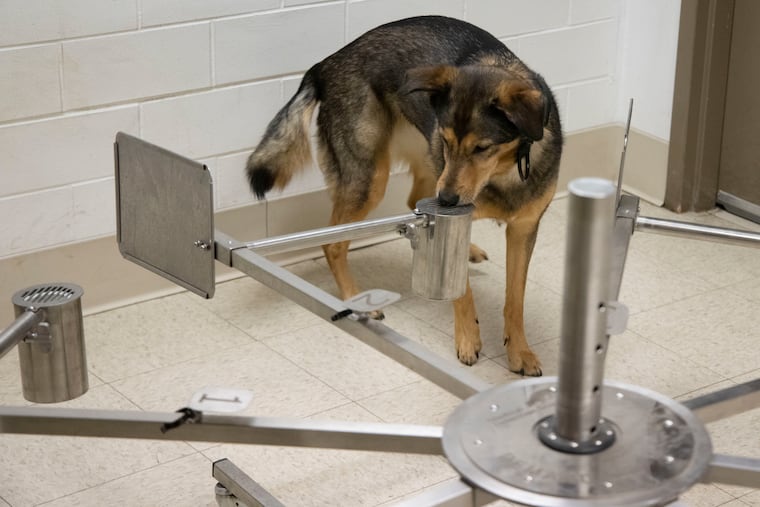At Penn, dogs are training to sniff out COVID-19 in asymptomatic carriers
Dogs are training to sniff out COVID-19 at the University of Pennsylvania Working Dog Center.

Toby and Tuukka burst through the door of Penn Veterinary Working Dog Center ears perked, tails wagging, and ready to go.
They’re not here to play. Toby, a 2-year-old Small Munsterlander with silky fur the color of dark chocolate, and Tuukka, a 7-year-old mutt from Austria, are training for an important mission: Learn how to sniff out an invisible illness that can spread quickly, even before carriers show any symptoms.
With more sensitive noses than humans, dogs like Toby and Tuukka have trained at the University of Pennsylvania Working Dog Center to sniff out all sorts of things — bombs, illegal drugs, bedbugs, and low blood sugar in people with diabetes. There’s even a corgi training to detect nasal cancer.
Now researchers are teaching dogs to detect COVID-19. The skill could be used to screen for asymptomatic carriers of the coronavirus at airports, sporting events, schools, “pretty much any place you have large gatherings where everyone can go through one door,” said Cindy Otto, director of the Working Dog Center.
The applications are promising, but training dogs to detect a disease like COVID-19 isn’t easy. Explosives, illicit drugs, human remains, and other physical things dogs can be trained to find have a scent humans can smell, too. It’s easy to know when the item has been found because both dog and trainer can see it.
Researchers have found that illnesses and medical conditions are also associated with distinct scents — but only the dogs can smell them.
A preliminary study by Penn found that COVID-19 does, indeed, have a unique scent that dogs are able to identify. In the study, which began last summer, nine dogs (eight Labrador retrievers and a Belgian Malinois) with no previous experience with medical detection identified samples from people who tested positive for COVID-19 with 96% accuracy. The test subjects’ gender, age, or race didn’t matter — the dogs could hunt down signs of the virus.
“We don’t know exactly what the animal is using to identify the disease,” said Pat Nolan, a dog trainer in Maryland who worked with Penn on the study’s first phase. “They’re not actually trying to smell the virus itself but the changes in the body when the body is fighting the virus.”
Researchers used a “scent wheel” with samples from people who were COVID-19 negative and one who was positive for the virus. The dogs learn to recognize that one smells different from the others. When they find the sample that’s different, they get a treat.
Within eight weeks, the dogs in the study were able to identify which samples were from people with COVID-19.
“They are amazing animals,” Nolan said. “They bring skills to projects that we don’t have — they have better hearing, better nose, they’re more agile.”
And don’t worry, no dogs were put at risk of contracting COVID-19. The dogs practiced first with urine, which has been shown to have a low likelihood of active virus, before moving on to sweat samples on T-shirts that were treated to deactivate the virus.
Eventually the dogs will need to be able to reliably identify the scent among people so accurately, their findings yield a low rate of false positives and false negatives. Otto would like to develop a standard training that could be used among dogs elsewhere.
But first, the dogs need more practice. Toby and Tuukka work with a scent wheel loaded with sweaty T-shirts from volunteers up to three times a week.
Researchers include one T-shirt worn overnight by an individual who is COVID-19 positive, four shirts from people who are not sick, and some “distractor” smells, such as permanent marker, tape, and shipping materials.
Toby, a Small Munsterlander, a type of hunting dog, was born for this job. He was donated to the Working Dog Center by a breeder in California when he was 8 weeks old and has grown into an overly enthusiastic goofball. Tuukka, the more serious of the two, is a “citizen science dog” who belongs to Jenny Essler, a postdoctoral research fellow at the center. Toby also lives with Essler.
“They’re both very sensitive dogs, which maybe is what helps them to be good at this task,” Otto said.
When it’s his turn, Toby prances around the wheel, sniffing each spoke before finding the one he’s looking for. He freezes, then bounds out of the testing room to collect his prize — a piece of cheese and a good ear scratch.
University of Pennsylvania Working Dog Center is seeking volunteers for its T-shirt study. Sign up at www.surveymonkey.com/r/K9Tshirt